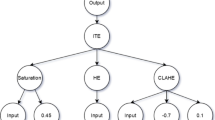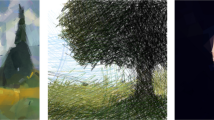Abstract
We present a study demonstrating how random walk algorithms can be used for evolutionary image transition. We design different mutation operators based on uniform and biased random walks and study how their combination with a baseline mutation operator can lead to interesting image transition processes in terms of visual effects and artistic features. Using feature-based analysis we investigate the evolutionary image transition behaviour with respect to different features and evaluate the images constructed during the image transition process.
Access this chapter
Tax calculation will be finalised at checkout
Purchases are for personal use only
Similar content being viewed by others
Notes
- 1.
Images and videos are available at https://vimeo.com/anetaneumann.
References
Romero, J., Machado, P. (eds.): The Art of Artificial Evolution: A Handbook on Evolutionary Art and Music. Natural Computing Series. Springer, Heidelberg (2008)
Antunes, R.F., Leymarie, F.F., Latham, W.H.: On writing and reading artistic computational ecosystems. Artif. Life 21(3), 320–331 (2015)
Lambert, N., Latham, W.H., Leymarie, F.F.: The emergence and growth of evolutionary art: 1980–1993. In: International Conference on Computer Graphics and Interactive Techniques, SIGGRAPH 2013, Anaheim, CA, USA, July 21–25, 2013, Art Gallery, 367–375. ACM (2013)
McCormack, J., d’Inverno, M. (eds.): Computers and Creativity. Springer, Heidelberg (2012)
Vinhas, A., Assunção, F., Correia, J., Ekárt, A., Machado, P.: Fitness and novelty in evolutionary art. In: Johnson, C., Ciesielski, V., Correia, J., Machado, P. (eds.) EvoMUSART 2016. LNCS, vol. 9596, pp. 225–240. Springer, Cham (2016). doi:10.1007/978-3-319-31008-4_16
al-Rifaie, M.M., Bishop, J.M.: Swarmic paintings and colour attention. In: Machado, P., McDermott, J., Carballal, A. (eds.) EvoMUSART 2013. LNCS, vol. 7834, pp. 97–108. Springer, Heidelberg (2013). doi:10.1007/978-3-642-36955-1_9
Greenfield, G.: Avoidance drawings evolved using virtual drawing robots. In: Johnson, C., Carballal, A., Correia, J. (eds.) EvoMUSART 2015. LNCS, vol. 9027, pp. 78–88. Springer, Cham (2015). doi:10.1007/978-3-319-16498-4_8
Todd, S., Latham, W.: Evolutionary Art and Computers. Academic Press Inc., Orlando (1994)
Greenfield, G., Machado, P.: Ant- and ant-colony-inspired alife visual art. Artif. Life 21(3), 293–306 (2015)
Machado, P., Correia, J.: Semantic aware methods for evolutionary art. In: Arnold, D.V., (ed.) Genetic and Evolutionary Computation Conference, GECCO 2014, Vancouver, BC, Canada, 12–16 July 2014, pp. 301–308. ACM (2014)
Sims, K.: Artificial evolution for computer graphics. In: Thomas, J.J., (ed.) Proceedings of the 18th Annual Conference on Computer Graphics and Interactive Techniques, SIGGRAPH 1991, pp. 319–328. ACM (1991)
Hart, D.A.: Toward greater artistic control for interactive evolution of images and animation. In: Giacobini, M. (ed.) EvoWorkshops 2007. LNCS, vol. 4448, pp. 527–536. Springer, Heidelberg (2007). doi:10.1007/978-3-540-71805-5_58
Trist, K., Ciesielski, V., Barile, P.: An artist’s experience in using an evolutionary algorithm to produce an animated artwork. IJART 4(2), 155–167 (2011)
Graf, J., Banzhaf, W.: Interactive evolution of images. In: Evolutionary Programming, pp. 53–65 (1995)
Karungaru, S., Fukumi, M., Akamatsu, N., Takuya, A.: Automatic human faces morphing using genetic algorithms based control points selection. Int. J. Innovative Comput. Inf. Control 3(2), 1–6 (2007)
Gatys, L.A., Ecker, A.S., Bethge, M.: Image style transfer using convolutional neural networks. In: Proceedings of the IEEE Conference on Computer Vision and Pattern Recognition, pp. 2414–2423 (2016)
Neumann, A., Alexander, B., Neumann, F.: The evolutionary process of image transition in conjunction with box and strip mutation. In: Hirose, A., Ozawa, S., Doya, K., Ikeda, K., Lee, M., Liu, D. (eds.) ICONIP 2016. LNCS, vol. 9949, pp. 261–268. Springer, Cham (2016). doi:10.1007/978-3-319-46675-0_29
Jansen, T., Sudholt, D.: Analysis of an asymmetric mutation operator. Evol. Comput. 18(1), 1–26 (2010)
Witt, C.: Tight bounds on the optimization time of a randomized search heuristic on linear functions. Comb. Probab. Comput. 22(2), 294–318 (2013)
Sudholt, D.: A new method for lower bounds on the running time of evolutionary algorithms. IEEE Trans. Evol. Comput. 17(3), 418–435 (2013)
Lovász, L.: Random walks on graphs: A survey. In: Miklós, D., Sós, V.T., Szőnyi, T. (eds.) Combinatorics, Paul Erdős is Eighty, vol. 2, pp. 353–398. János Bolyai Mathematical Society, Budapest (1996)
Dembo, A., Peres, Y., Rosen, J., Zeitouni, O.: Cover times for brownian motion and random walks in two dimensions. Ann. Math. 160(2), 433–464 (2004)
Mersmann, O., Preuss, M., Trautmann, H.: Benchmarking evolutionary algorithms: Towards exploratory landscape analysis. In: Schaefer, R., Cotta, C., Kołodziej, J., Rudolph, G. (eds.) PPSN 2010. LNCS, vol. 6238, pp. 73–82. Springer, Heidelberg (2010). doi:10.1007/978-3-642-15844-5_8
Mersmann, O., Bischl, B., Trautmann, H., Wagner, M., Bossek, J., Neumann, F.: A novel feature-based approach to characterize algorithm performance for the traveling salesperson problem. Ann. Math. Artif. Intell. 69(2), 151–182 (2013)
Nallaperuma, S., Wagner, M., Neumann, F., Bischl, B., Mersmann, O., Trautmann, H.: A feature-based comparison of local search and the christofides algorithm for the travelling salesperson problem. In: Neumann, F., Jong, K.A.D., (eds.) Foundations of Genetic Algorithms XII, FOGA 2013, Adelaide, SA, Australia, 16–20 January 2013, pp. 147–160. ACM (2013)
Nallaperuma, S., Wagner, M., Neumann, F.: Analyzing the effects of instance features and algorithm parameters for max-min ant system and the traveling salesperson problem. Front. Robot. AI 2, 1–16 (2015)
Poursoltan, S., Neumann, F.: A feature-based prediction model of algorithm selection for constrained continuous optimisation. CoRR abs/1602.02862 Conference version appeared in CEC 2016(2016)
Neumann, F., Wegener, I.: Randomized local search, evolutionary algorithms, and the minimum spanning tree problem. Theor. Comput. Sci. 378(1), 32–40 (2007)
Grady, L.: Random walks for image segmentation. IEEE Trans. Pattern Anal. Mach. Intell. 28(11), 1768–1783 (2006)
Mitzenmacher, M., Upfal, E.: Probability and Computing: Randomized Algorithms and Probabilistic Analysis. Cambridge University Press, New York (2005)
Jolion, J.M.: Images and benford’s law. J. Math. Imaging Vis. 14(1), 73–81 (2001)
Matkovic, K., Neumann, L., Neumann, A., Psik, T., Purgathofer, W.: Global contrast factor-a new approach to image contrast. Comput. Aesthetics 2005, 159–168 (2005)
Hasler, D., Suesstrunk, S.E.: Measuring colorfulness in natural images. In: Electronic Imaging 2003, International Society for Optics and Photonics, pp. 87–95 (2003)
den Heijer, E., Eiben, A.E.: Investigating aesthetic measures for unsupervised evolutionary art. Swarm Evol. Comput. 16, 52–68 (2014)
Acknowledgement
This work has been supported through Australian Research Council (ARC) grant DP140103400.
Author information
Authors and Affiliations
Corresponding author
Editor information
Editors and Affiliations
Rights and permissions
Copyright information
© 2017 Springer International Publishing AG
About this paper
Cite this paper
Neumann, A., Alexander, B., Neumann, F. (2017). Evolutionary Image Transition Using Random Walks. In: Correia, J., Ciesielski, V., Liapis, A. (eds) Computational Intelligence in Music, Sound, Art and Design. EvoMUSART 2017. Lecture Notes in Computer Science(), vol 10198. Springer, Cham. https://doi.org/10.1007/978-3-319-55750-2_16
Download citation
DOI: https://doi.org/10.1007/978-3-319-55750-2_16
Published:
Publisher Name: Springer, Cham
Print ISBN: 978-3-319-55749-6
Online ISBN: 978-3-319-55750-2
eBook Packages: Computer ScienceComputer Science (R0)




